
| 
|

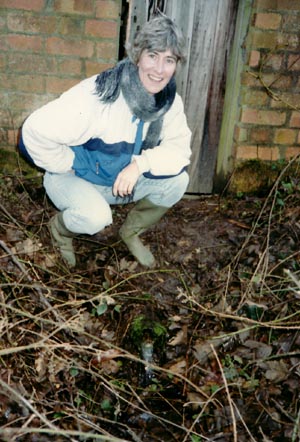
Ballards Spring
NGR 76663 42860
Site Number: C50
By Bruce Osborne and Cora Weaver (C) 2012
Area 5. Malvern Wells Area Springs and Wells
Malvern Hills, England
Description: a spring contained in a cistern within a shed.
This source is on the Ballard family's private property. It is usually known as Ballard's Spring but also as the Glenwood Spring, although Glenwood House is about 150 yards north of the spring. Richardson notes two springs 150 yards apart and these are discussed under 'Original Primeswell' (48).
The cistern into which the spring emerges is covered by a brick-built shed that is normally locked. The cistern overflows into a west-flowing brook. The estimated output of the spring is 10 - 16 gallons per minute, depending on rainfall.
Uses of the Water - The extensive Ballard lands, including this spring, were bought by Stephen Ballard I (1804-1890). Bottling was originally carried out in a small shed on a piece of levelled ground just below the source. From 1883 - 1914 the spring supplied Ballard's Vinegar Brewery in Colwall and the vinegar won silver medals at the Trade Shows in Paris in 1889 and Edinburgh in 1990. The British Trade Journal noted that "...the vinegar itself is guaranteed to be purely of malt, the brewery being supplied exclusively with the celebrated Malvern water, whose qualities are world-renowned."[1] The Vinegar Brewery was sold in 1914 and became a cannery, which closed in the 1960s.
In 1890 Ballard entered into an agreement with Schweppes to supply water to their new Colwall bottling plant. The cost to Schweppes was 220 pounds per annum for 21 years, and they bottled at the Vinegar Brewery for eighteen months before their new Colwall buildings were completed. The contract with Stephen Ballard assured a prolific supply from his Glenwood spring and legend has it that the 87 pounds 10 shillings due for the temporary Vinegar Works facility is still outstanding. Schweppes' bottled water was known and marketed as Glenwood Spring at this time. Circa 1925 the Glenwood spring became polluted and Schweppes were having their bottled water returned. George Ballard (he inherited from Stephen Ballard) ran a main from Moorall's Well or Pitts Spring to Schweppes but by them Schweppes had negotiated the purchase of W & J Burrow and acquired, from Alan Bright of Barton Court, the rights to water from the Pewtriss Spring, which they used until closing the Colwall bottling plant in 2010. They renamed the Pewtriss Spring the Primeswell.
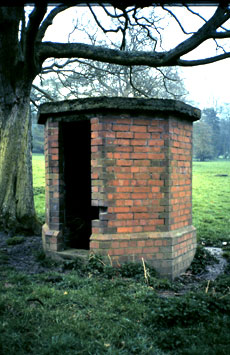
Ballard's spring was - and is still - used for the family's private water undertaking and is mentioned by Richardson in 1930.[2] It fed Winnings and other houses owned by Ballards in Colwall. This source and Mooralls Well provided a private water supply to about 130 houses, though this number has been substantially reduced in recent years. The two sources could be connected through the pipework, although each essentially had its own distribution network. There is a most interesting valve chamber related to the private supplies in the field just east of the western end railway tunnel portal. It is a red brick hexagonal building now rapidly deteriorating.
In 1948 Ballards ran water and sewer services to The Beacon Cafe on the Worcestershire Beacon, though the Cafe was derelict at the time.
The chemical analysis of the water taken by Schweppes in 1890, supplied from the Ballard family archives, included the following comment:
"It was an extraordinary specimen of fine soft water and it closely resembled distilled water".
Geo. Browner F.R.S. [3]
The Ballard Family - A long-established Colwall family, the Ballards have been frequently involved in local activities. A John Ballard was vicar of Malvern between 1644 and 1653 and in 1802 the Ballard family subscribed to C H Tatham's restoration scheme at Malvern Priory. Philip Ballard is listed as an attorney in the 1820 County Directory and later in the nineteenth century the brickmaker Robert Ballard, brother of Stephen Ballard I, between them built the spectacular Ledbury viaduct.
The most famous member of the family was Stephen Ballard I, born in 1804 at Pickersleigh Court
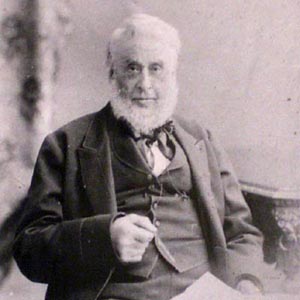 and later resident at Winnings in Colwall. He started his career as a drainage engineer but subsequently gained railway experience working with Brassey, one of the foremost engineers of the day and the engineer on the local line. Ballard was responsible for the opening of both of the railway tunnels on the Hereford to Malvern railway, one at Ledbury and the other through the Malvern Hills. They were 1,323 yards and 1,567 yards long respectively and were considerable engineering feats in their day. The line was opened to traffic in 1861 although the Malvern Tunnel was subsequently replaced (See Railway Station Fountain and Railway Tunnel). In 1887, the year of the Queen's Golden Jubilee, Ballard engineered the Jubilee Drive from the Wyche to Gardiner's Common. The first Malvern Hills Act was passed in 1884 in an attempt to overcome the problem of encroachment on the common and Stephen Ballard I was one of the principal landowners whose cooperation enabled the Commons Society to secure the legislation. Ballard died in 1890 at the age of 86 and his grave and monument lie above Broadwood House in Broadwood Drive near the circular shaft vent of the railway tunnel. The inscription on the monument reads:
and later resident at Winnings in Colwall. He started his career as a drainage engineer but subsequently gained railway experience working with Brassey, one of the foremost engineers of the day and the engineer on the local line. Ballard was responsible for the opening of both of the railway tunnels on the Hereford to Malvern railway, one at Ledbury and the other through the Malvern Hills. They were 1,323 yards and 1,567 yards long respectively and were considerable engineering feats in their day. The line was opened to traffic in 1861 although the Malvern Tunnel was subsequently replaced (See Railway Station Fountain and Railway Tunnel). In 1887, the year of the Queen's Golden Jubilee, Ballard engineered the Jubilee Drive from the Wyche to Gardiner's Common. The first Malvern Hills Act was passed in 1884 in an attempt to overcome the problem of encroachment on the common and Stephen Ballard I was one of the principal landowners whose cooperation enabled the Commons Society to secure the legislation. Ballard died in 1890 at the age of 86 and his grave and monument lie above Broadwood House in Broadwood Drive near the circular shaft vent of the railway tunnel. The inscription on the monument reads: East Face: Stephen Ballard born April 5 1804 died November 11 1890 "Thy will be done."
South Face: Maria wife of Stephen Ballard born 1 January 1829 died 19 April 1915 "Called into his marvellous light."
West Face: Fred Ballard born 23 December 1860 died 13 September 1940 and his wife Mary born 14 October 1878 died 1 February 1955
North Face: Mary daughter of Stephen and Maria Ballard born 14 May 1859 died 14 September 1929 "Fruitless before his presence with exceeding joy."
1. Outside the shed that contains a cistern in the 1990s, the overflow can be seen below Cora.
2. The spring containment shed now overgrown.
3. The valve chamber.
4. Stephen Ballard I. (courtesy Malvern Museum)
Footnotes:
[1] Malvern Advertiser, 28 August 1897.
[2] Richardson, L. 1930, Wells and Springs of Worcestershire, p117.
[3] courtesy of the Ballard family archives.
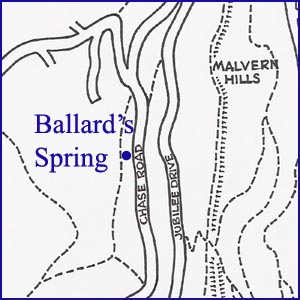
Website: Click Here
SUPPLEMENTARY INFORMATION

Celebrated Springs of
THE MALVERN HILLS
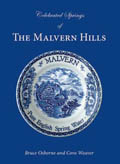 A definitive work that is the culmination of 20 years researching the springs and wells of the Malvern Hills, published by Phillimore. This is the ideal explorers guide enabling the reader to discover the location and often the astounding and long forgotten history of over 130 celebrated springs and wells sites around the Malvern Hills. The book is hard back with dust cover, large quarto size with lavish illustrations and extended text. Celebrated Springs contains about 200 illustrations and well researched text over a similar number of pages, together with seven area maps to guide the explorer to the locations around the Malvern Hills. It also includes details on the long history of bottling water in the Malvern Hills.
A definitive work that is the culmination of 20 years researching the springs and wells of the Malvern Hills, published by Phillimore. This is the ideal explorers guide enabling the reader to discover the location and often the astounding and long forgotten history of over 130 celebrated springs and wells sites around the Malvern Hills. The book is hard back with dust cover, large quarto size with lavish illustrations and extended text. Celebrated Springs contains about 200 illustrations and well researched text over a similar number of pages, together with seven area maps to guide the explorer to the locations around the Malvern Hills. It also includes details on the long history of bottling water in the Malvern Hills.
1) TOPOGRAPHICAL LOCATION:
Malvern Hills - arguably Britain's original National Park
2) LANDSCAPE:
Farmland3) INFORMATION CATEGORY:
A Spring, Spout, Fountain or Holy Well Site4) MALVERN SPRING OR WELL SITE DETAILS:
Site with Malvern Water2 SPLASHES - Not Much To See
 Water Bottling - Past or Present
Water Bottling - Past or Present5) GENERAL VISITOR INFORMATION:
Access On FootOn Private Property
Not Open To Public
Free Parking Nearby


